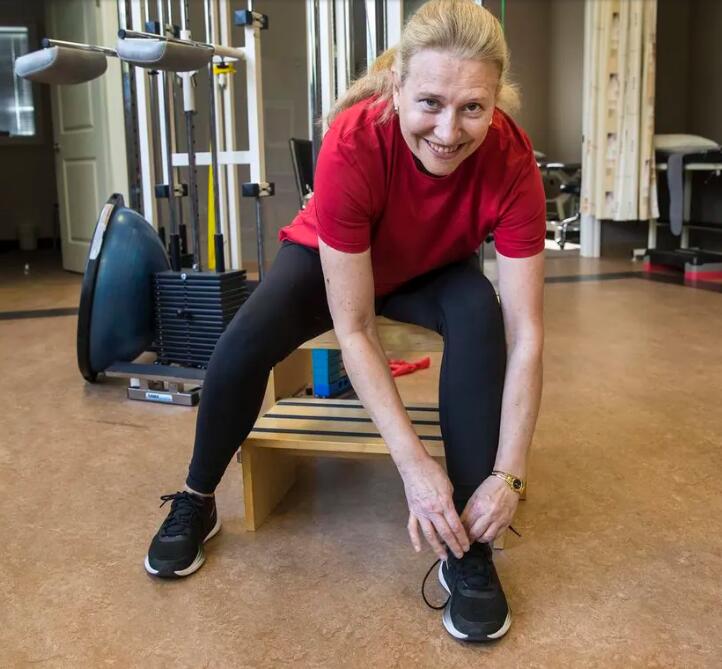:format(webp)/https://www.thestar.com/content/dam/thestar/business/2022/06/06/lululemon-has-launched-its-first-women-first-running-shoe-but-what-exactly-does-that-mean/shoe_closeup.jpg)
A year later, U.S. track athlete and five-time Olympian Allyson Felix co-founded women’s shoe brand Saysh, after struggling to secure a shoe sponsorship following her pregnancy and speaking out on inequities between women and men in professional sport.
The early flagship model, the Saysh One, features a narrower heel and wider toe box than a typical running shoe, and sells for $150 (U.S.). Clarks Shoes And the company offers free sneakers to women whose shoe foot size changes during pregnancy. Its new track spike for women, however, is not so affordable: it sells for $2,500 a pair.
In 2010, ASICS came out with the more questionable Gel Kayano 16, whose adaptable arch shape was ostensibly designed to match female hormone levels. It was inspired by research that showed that monthly changes in estrogen levels affected foot flexibility and arch height. Recent versions of the Kayano, however, no longer advertise this technology.
The Blissfeel may be making headlines, but experts say we are still far from creating the perfect shoe for women. For instance, little is known about how running shoe dimensions impact injury risk and running performance in women — or in men for that matter.
Michaela Khan, a PhD student in clinical biomechanics at the University of British Columbia, said that women tend to sustain different running-related injuries than men, specifically stress fractures, but risk factors are manifold. Differences in anatomy and running technique between males and females may play a role. But these differences do not always exist and none have been consistently proven as the culprit, Khan said, adding we know even less about the role shoes play in this.
I love the sentiment of focusing on females,” said Khan, whose own research explores how running affects our knees, “but wearing ‘female’ shoes may not fix anything in terms of running-related injuries, because we’re not even sure what to fix.”
Meanwhile, Paquette and other researchers focusing on running performance say they are in the early stages of learning how women and men respond differently to racing shoes when running fast.
Paquette said while this type of research is ongoing in his lab, one of the only conclusions so far is that women, on average, are more reliant on their calf muscles than men, so shoes that encourage calf muscle use may be better suited for women.
“Otherwise,” he said, “the gender differences in running biomechanics are still pretty murky, which makes it hard to hypothesize footwear effects in elite-level running.”
Paquette hopes we eventually see the advent of high-performance shoes for women.
So while the Blissfeel may accommodate some traditionally female foot features, it is no match on the race course to the more specialized sneakers of the day such as the Nike Next% or the Adidas Adios Pro, which both harbour carbon plates and hard, springy foam stacked at 40 mm for maximum spring-off (the Blissfeel has no carbon plate and a lower stack height of 32.5 mm).
Amanda Lee, a pedorthist and runner from Fredericton, N.B., took the Blissfeel for a spin. She liked them for walking, but on her runs, they lacked the responsiveness of other shoe. She prefers her usual Hoka One One Cliftons.
“The Blissfeel might have been made for women,” said Lee, “but I much preferred my traditional shoes for running. I think that, at the end of the day, it just depends on personal variability.”
Even if the Blissfeel does not suit every woman’s foot, Paquette said he hopes the shoe and others designed for women’s feet will normalize gender parity in product testing, and eventually lead to more products that suit the physiology of women and men. Already, Lululemon plans to draw on its Blissfeel research to expand its footwear Hokas Shoes collection with a women’s workout shoe, a women’s training shoe, and eventually footwear for men.
“I think there is a huge gap to fill in running footwear science to address differences between genders,” Paquette said. “It’s a good time to research running and shoes.”
For Oldfield, the physiotherapist, it also feels like a good time to be a runner. She wonders if she’ll ever go back to buying shoes that are not specifically made for women, and hopes an increasing number of brands conceive their own shoes for women.
“The Blissfeel just feels like it’s made for my foot,” she said. “If that’s where science is now — creating sneakers made specifically for women — it’s really exciting.”
Lululemon Blissfield Stats
Cost: $198
Category: neutral cushioning
Weight: 251 g (8.9 oz.)
Heel to toe drop: 9.5 mm
Stack height: 32.5 mm
Colourways: 10

Comments (0)